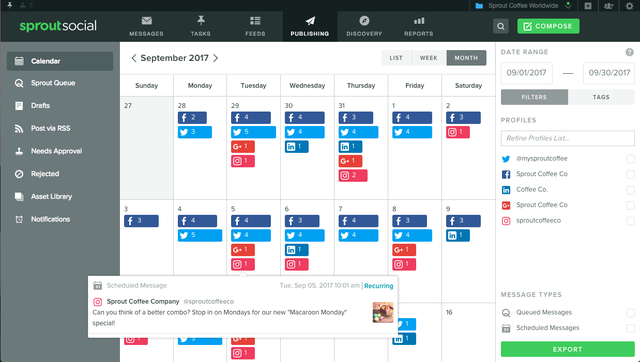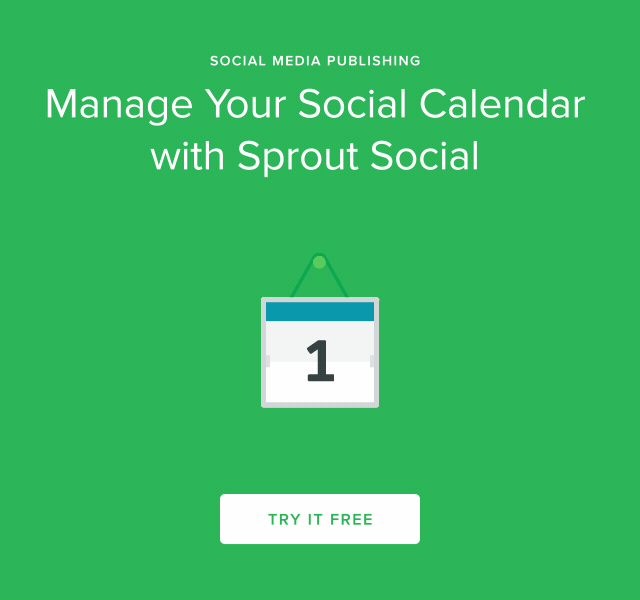If you’re not taking the time to plan your social media calendar in advance, you could end up scrambling to find content to share. This is a big problem because sharing quality content across your social channels is one of the most important things you can do to engage your audience and attract new followers.
That’s why one of the most critical things marketers can do is take the time to plan out their own social media content calendar. Social content calendars allow you to plan and schedule out months of quality social posts ahead of time, and save a ton of time sharing it on social.
This post details how you can create a unique social media editorial calendar, and some of the tools that make it easy to find and share social content.
Sprout features mentioned in this post:
Why You Need a Social Editorial Calendar
Sometimes brands can churn out social posts very quickly. For instance, Totino’s immediately jumped on Twitter with a witty Tweet in response to Saturday Night Live’s pizza roll skit for the Super Bowl.
*watches new @nbcsnl*
*sees another Totino’s parody ad*
*sighs, logs in to work email for the next 12 hours*— Pete Zaroll (@totinos) February 5, 2017
But more often than not, it takes companies more than a few minutes to find or create something to share. Campaigns like #MBPhotoPass from Mercedes-Benz don’t come together in a matter of minutes. It can take months of planning and tweaking to keep the campaign fresh and effective.
Plus, real-time marketing relies heavily on happenstance and coincidence. There’s no way Oreo could’ve planned on a blackout during the 2013 Super Bowl. But the reward was massive.
Planning social media posts in advance ensures you always have quality content to share with your audience on a consistent basis. A social media calendar builds the framework for what you’re going to share, then you can fill in the gaps by manually sharing posts, responding to incoming messages and engaging with your audience.
Lastly, a social media editorial calendar is important because you can schedule content at the optimal time. With more networks switching to algorithm based feeds, you need to do anything you can to get more exposure for your posts. One simple tactic you can use is to post when your audience is most active. We wrote an entire post on the best times to post on social media that will give you great insights. For instance, we found posting weekday afternoons is optimal for Twitter.
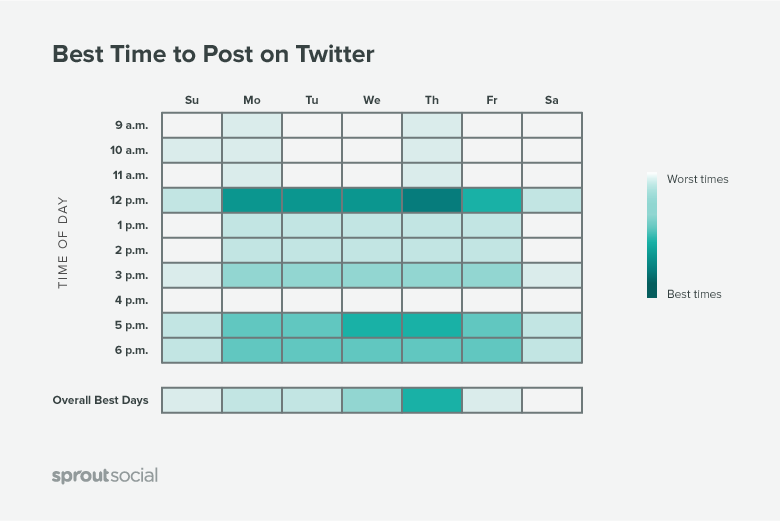
In addition to our research, you should also look into your own analytics, which we’ll dive into later.
There’s nothing worse than realizing you don’t have anything to share at the last minute. Plan ahead so you don’t get caught off guard.
How to Create Your Social Media Editorial Calendar
If your company is new to the idea of setting up an editorial calendar for social, or if you want to take a look at a unique way of setting one up, here’s a simple four-step process for implementing and maintaining an efficient social media calendar for your brand:
1. Figure Out What Content Resonates
Before you start searching for content to share on social, you need to figure out what your audience actually likes. A fantastic way to do that is to look at past social media posts to see which were most successful. We’ve written an in-depth article on how to find your successful posts by conducting a social media audit, but the easiest way is to access your analytics.
Pull all of your unique social media analytics with a tool like Sprout Social, Twitter or Facebook Insights. Below is an example of how to view your Sent Messages with Sprout (available with a free trial).

Make sure you’re sorting your messages by the metric that is most important to you, whether that’s clicks, responses or total reach. Once you have an idea of what kind of content works best, you can move onto the next step.

2. Decide On How Often to Post
This step depends on a handful of different things like the company, your audience, the campaign, and the social networks being used. Always keep your audience in mind and ensure you’re not bombarding them with posts that are irrelevant or inappropriate.
If you’re looking for some basic standards, though, Constant Contact wrote a post containing guidelines on how often to post to social. Here are some of the highlights:
- Facebook: 3-10 times per week
- Twitter: at least 5 times a day
- LinkedIn: 2-5 times per week
- Google+: 3-10 times per week
- Pinterest: 5-10 times per day
There’s a great chance your post frequency will depend on the amount, experience and authority of your social media team, so don’t feel like you have to send out less than stellar content to meet these guidelines.
Again, your brand’s analytics can be extremely helpful here. You can use Sprout to see how often you post on each social network.
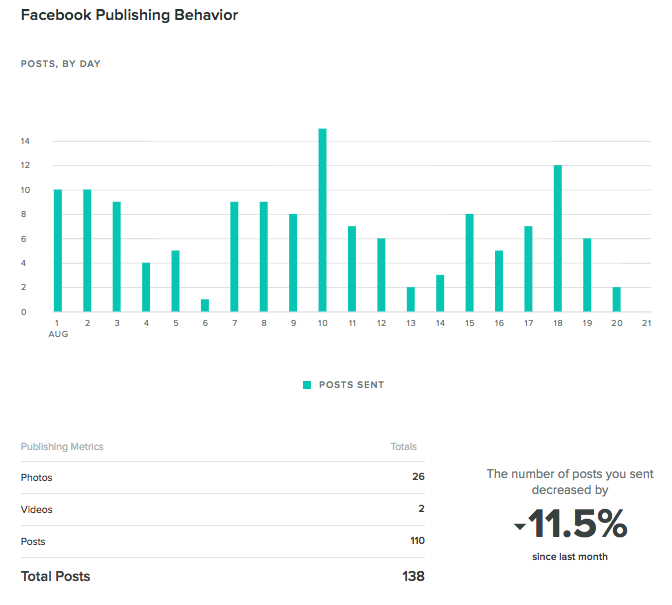
Then compare that against how much engagement you received over that same period of time.

Look for trends between publishing rate and engagement. The screenshots above are from our Facebook analytics report, but you can do the same for Twitter, Instagram and LinkedIn posts as well.
3. Create or Source Great Content to Share
Once you have an idea of what kind of content your audience enjoys and how often you need to post, it’s time to find links to share. If you don’t have enough of your own content to fill your calendar, use these tools to curate relevant content.
Buzzsumo allows you to type in any website domain or keyword string and the platform returns the most socially shared content around that subject. For example, if Sprout Social was looking for quality articles to share we might type in a keyword like “Instagram marketing.”

Feedly aggregates all of the publications you care about into one stream, allowing you to easily scale your content discovery process. It also plugs in to various social media platforms, like Sprout Social, which makes the article scheduling process that much easier. After connecting your Feedly account, you can share the latest articles from your feeds right from Sprout.

Stumbleupon is an amazing tool for finding relevant content to share across your social profiles. You can select categories you’re most interested in, and Stumbleupon will surface relevant articles from around the web that you can “stumble” through one after another.

4. Fill up Your Social Media Editorial Calendar
You’ve got the process in place, now it’s time to fill up your editorial calendar. You’ll want to use a tool that allows you to schedule your social messages and visualize your entire content calendar. Sprout Social built powerful publishing tools for just this purpose. Check out a completely free trial and schedule a months worth of content today.
Fill in the calendar with links to relevant content, resources and your own posts. These social messages will ensure you’re providing your audience with smart, useful content and give them a reason to follow you. Additionally, you can find relevant holidays or events–from Thanksgiving to National Ice Cream Day–that you can tie in with your business. In fact, Sprout Social created it’s own hashtag holidays calendar so you can keep track of all the eccentric holidays. These timely events will help populate you calendar and bring personality to your feed.
Think through your must-haves, whether it is a product release or scheduled company announcement, and develop content to promote those initiatives. Additionally, make sure you’re planning out how much promotion each initiative warrants; some large releases should have multiple social posts while others only warrant one.
Lastly, pump up the personality of your editorial calendar by planning out posts that highlight company culture or showcase who you are as a brand.
Other Social Media Calendar Apps & Tools
If you’ve made it to step four, but need a separate tool for social media scheduling, never fear. Although not specifically created with social media in mind, there are a handful of different calendar apps that can help you out.
Trello is a project management tool that’s very popular with bloggers, marketers and social media managers. It’s a good way to keep track of your content ideas and even has an additional calendar add-on you can use to get a monthly view of your planned content.

WordPress Editorial Calendar Plugin
This plugin is mostly for planning and scheduling content for your blog, not social media. However, if you have your social profiles set to share your blog posts, it will take care of the social portion as well.
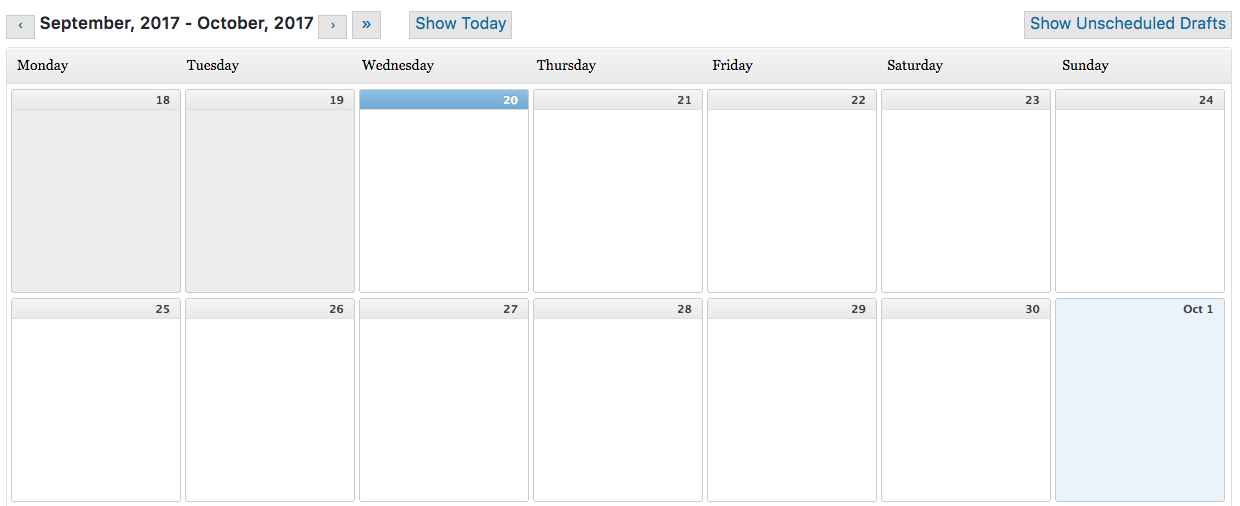
This is another editorial calendar tool that works right in WordPress. Edit Flow gives you the ability to view a month-by-month editorial calendar, write customer comments on the content and create segmented teams.

If you want to keep it simple, you could always just create a new Google calendar for the process and invite everyone on the team to view it. Those teammates could also add all of their own posts and ideas to the same calendar.

Managing Multiple Social Media Calendars
Managing a social media calendar for a single business can be a challenge of its own. But when you’re in charging of scheduling content for multiple profiles or clients, things get even trickier.
You absolutely need a dedicated social media calendar tool if you’re in charge of planning social content across multiple profiles. Trello, Basecamp and project management tools won’t cut it. Obviously, we recommend using Sprout.
With our platform, you can separate all of your different profiles into groups. Then you can create separate social media calendars for each group. This comes in handy for agencies, since you need to keep the calendars of all your clients separate and private. You can even set permission levels to give clients and team members restricted access. For instance, you may want a client to view your calendar, but not publish.

Another use case is planning out content for different profiles for the same company. For instance, Adidas has several social media accounts based on the locations they serve and their different product lines.

While each account speaks to a different audience, they each need a separate social media calendar to schedule content specific to the people they’re trying to reach. It keeps things organized and creates a way for the Adidas marketing team to see what’s scheduled to be shared on each channel.
Practice Makes Perfect
It can take even the most socially-savvy companies time to set up an effective workflow for creating and posting social media content. The main idea is to plan far enough ahead and give yourself time to work everything out with your teams so that each post is thought-out and strategically aligned by the time it reaches your audience.

